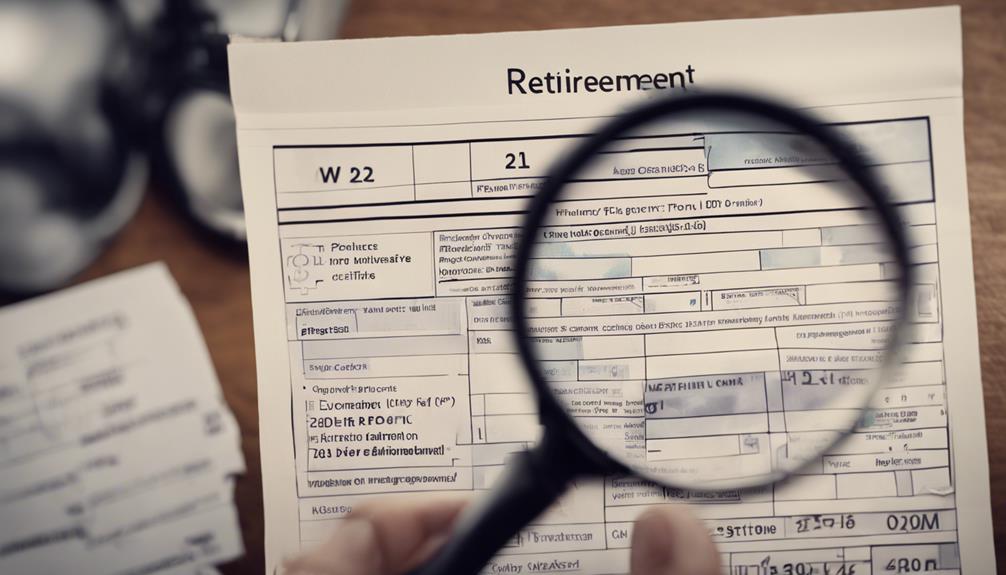Understanding the ‘Retirement Plan Checked’ on your W2 is crucial. It signifies active involvement in a retirement plan, which can impact your taxable income and tax liability. Checking this box could potentially lower your taxes and increase your savings. It is important to be accurate for effective tax planning. Box 13 confirms your participation status, which can affect deductions and credits. Errors in this section could result in tax complications. By increasing your contributions annually, you can maximize the benefits. Employer matching contributions can also boost your savings. Box 12 codes indicate different types of compensation, such as Code D for elective deferrals. Being aware of these codes can help you monitor your earnings and savings. Understanding your W2 form is key to efficient financial management and long-term benefits.
Key Takeaways
- Checking the retirement plan box on your W-2 indicates active participation in a retirement plan.
- Active participation can lower taxable income and reduce tax liability.
- Errors in reporting active participation may lead to tax discrepancies.
- Understanding Box 12 codes like Code D for 401(k) elective deferrals is crucial.
- Consulting a tax professional can help comprehend the implications for tax planning.
Types of Retirement Plan Contributions
When we consider types of retirement plan contributions, we often categorize them into employer-sponsored plans and individual retirement accounts. Employer-sponsored plans typically involve contributions from both the employer and the employees, including elective deferrals made by the employees, which are deducted directly from their paychecks. On the other hand, individual retirement accounts (IRAs) are funded solely by the individual, allowing for contributions or forfeitures based on the account holder's discretion.
Being classified as an active participant in a retirement plan can impact the tax treatment of contributions. This status is indicated on the W-2 form and helps determine the deductibility of traditional IRA contributions. Different codes in Box 12 of the W-2 provide detailed information about the specific retirement plan contributions made throughout the year, aiding in understanding the employee's plan participation. By knowing whether one is an active participant in a qualifying retirement plan, individuals can better navigate their retirement savings strategy and tax implications.
Impact on Taxable Income

Checking the retirement plan box on our W-2 forms signifies active participation in a qualifying retirement plan and has a direct impact on our taxable income. When this box is checked, it indicates to the IRS that we're contributing to a retirement plan, such as a 401(k) or 403(b). This information is important for tax purposes as it can influence how our contributions are treated.
By participating in a retirement plan, we may lower our taxable income, potentially reducing our overall tax liability for the year. Understanding the implications of this box on our W-2 is crucial for making informed decisions about our retirement savings and tax planning. It's a key element in managing our finances efficiently and maximizing the benefits of saving for retirement.
Therefore, paying attention to this box and its impact on our taxes can lead to significant long-term financial advantages.
Reviewing Your W-2 for Accuracy
Check your W-2 carefully to confirm the accuracy of the reported retirement plan status in Box 13. This box indicates whether you're an active participant in a retirement plan, which can impact your tax deductions and credits.
Ensuring that the retirement plan box is accurately filled out is vital for proper tax treatment and determining your eligibility for specific tax benefits. If there are any errors in this section, it could lead to discrepancies in your tax liability.
It's advisable to consult with a tax professional to fully grasp the implications of being marked as a participant in a retirement plan on your W-2. By reviewing your W-2 for accuracy, you can avoid potential issues and make sure that you're receiving the deductions and credits you're entitled to based on your retirement plan status.
Be proactive in verifying this information to prevent any tax-related complications down the line.
Maximizing Retirement Benefits

To enhance our retirement benefits, we should explore strategic ways to maximize our savings opportunities. One effective method is to increase contributions to our retirement accounts each tax year. By contributing more to our retirement plans, such as 401(k) or IRA accounts, we can take advantage of potential tax benefits and compound our savings over time. It's important to understand the contribution limits set by the IRS for each type of retirement account to make sure we're maximizing our savings within those guidelines.
Additionally, some employer-sponsored retirement plans offer matching contributions, which can greatly boost our retirement savings. Taking full advantage of employer matches can help us reach our retirement goals faster.
Regularly reviewing our W-2 forms to ensure our retirement plan status is accurately reported is essential for maximizing retirement benefits. This information not only impacts our tax treatment but also determines our eligibility for various tax deductions and credits related to retirement savings. Seeking guidance from a tax professional can further optimize our retirement planning strategy.
Understanding Box 12 Codes
Box 12 codes on your W-2 form are essential as they indicate specific types of employee compensation or benefits. For example, code D is for elective deferrals under a 401(k) plan, while code E represents amounts deferred under a 403(b) agreement. Understanding these codes provides detailed insight into your earnings and benefits reported on your W-2.
Box 12 Code Meaning
Understanding the meanings of the Box 12 codes on your W-2 form is essential for correctly categorizing different types of income received. When you see Code D in Box 12, it indicates elective deferrals under a 401(k) plan. This means that the amount listed under this code reflects the money you chose to contribute to your 401(k) retirement plan from your paycheck before taxes were applied.
Being aware of this code helps you track your retirement savings and understand how much you've set aside for the future. It's important to pay attention to these codes as they provide valuable information about your income sources and contributions towards your retirement plan.
Common Box 12 Codes
We can identify various common Box 12 codes on your W-2 that denote specific types of income and contributions towards retirement plans. Code D signifies elective deferrals under a 401(k) plan, while Code E represents the amount of salary deferred under a 403(b) agreement.
Code F shows the amount of salary deferred under a 408(k)(6) agreement, and Code G includes elective and non-elective deferrals to a section 457(b) plan. Code H reflects the amount of salary deferred to a section 501(c)(18)(D) plan.
Understanding these codes is essential for comprehending the amount contributed to your retirement account as indicated on your Form W-2. It provides clarity on the various sources of income that have been allocated towards securing your financial future.
Importance of Retirement Plan Checked

Why is it essential to have the retirement plan box checked on your W-2 form?
Checking this box is important for various reasons:
- Tax Reporting: When the retirement plan box is checked, it signifies your active participation in a retirement plan. This information is crucial for accurate tax reporting and can influence how your contributions are treated for tax purposes.
- Tax Deductions: Having this box checked helps determine your eligibility for specific tax deductions related to retirement savings. It can affect the amount you can deduct from your taxable income, potentially lowering your tax liability.
- IRS Reporting: Employers use the retirement plan indicator to report your participation in a retirement plan to the IRS. Ensuring this box is correctly marked on your W-2 is important for proper tax filing and compliance.
Frequently Asked Questions
What Happens if Retirement Plan Is Checked on W-2?
If retirement plan is checked on your W-2, it shows active participation in a qualifying retirement plan. This may impact tax reporting, contributions treatment, and taxable income.
The IRS uses this to determine eligibility for certain tax benefits related to retirement savings.
It's important to verify this info is accurate for proper tax filing and IRS compliance. Consulting a tax professional can help navigate how this status impacts your overall tax situation.
What Part of W-2 Shows Retirement Contributions?
When looking at your W-2, the retirement contributions are typically shown in Box 12 with codes that correspond to different types of benefits and compensation. This section reveals key details about the retirement contributions made during the tax year, helping individuals track their savings and plan for the future.
Make sure to review this part of your W-2 closely to gain insights into your retirement savings strategy.
What Does It Mean if Box 13 Is Checked on W-2?
When Box 13 is checked on your W-2, it means you're actively participating in a retirement plan. This can impact how much you can deduct for traditional IRA contributions.
The specific retirement plan you're enrolled in will be detailed under different Internal Revenue Code sections in Box 13. Employers use this information to demonstrate your involvement in retirement plans to the IRS.
It's essential for tax purposes, influencing how your contributions and taxable income are treated.
What Does Box 14 of W-2 Say About Retirement?
Box 14 on your W-2 captures additional details like union dues, educational aid, or post-tax retirement contributions. This section serves to inform without altering federal tax calculations.
Employers may include various compensations or deductions, and state-specific info like disability insurance. It's a breakdown beyond regular wages, offering insight into your overall benefits and financial picture.
What Does “Retirement Plan Checked” Mean on My W2 and How Can I Cancel My Retirement Plan?
The “Retirement Plan Checked” box on your W2 indicates you’re enrolled in a workplace pension scheme. If you’re pondering a stepbystep retirement plan cancellation, it’s crucial to review the policy carefully for potential penalties or implications. Consulting a financial advisor is often the best first step to ensure that cancelling aligns with your long-term financial goals.
Conclusion
Understanding your W-2 and the 'retirement plan checked' box is essential for maximizing your retirement benefits and minimizing your taxable income. By reviewing this information carefully, you can guarantee accuracy and make informed decisions about your financial future.
Don't overlook the significance of retirement planning – it's never too early to start saving for retirement and securing your financial well-being down the line. Make sure to consult with a financial advisor for personalized guidance.











